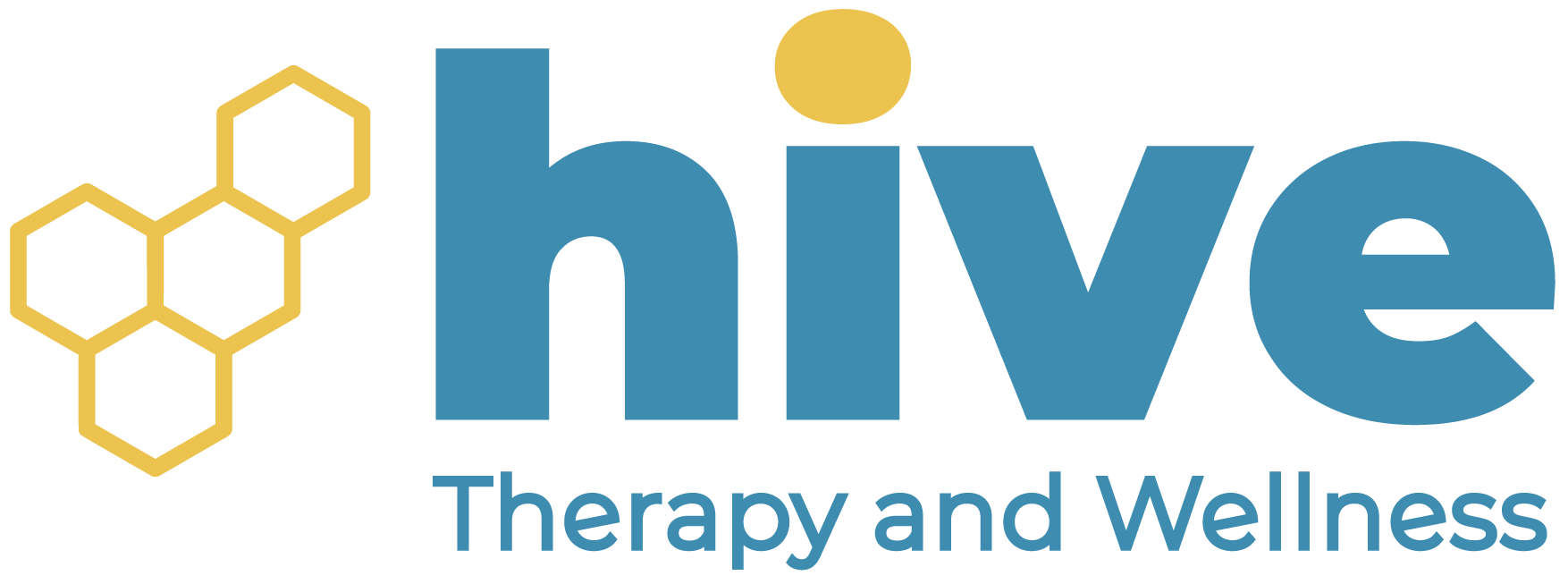Cupping
Cupping treatment uses suction to increase blood flow, mobilize scar tissue and reduce inflammation.
What Is Cupping?
Cupping therapy is one of the many physical therapy treatments we are happy to offer at Hive Therapy and Wellness. It is a technique used to achieve fascial decompression on a target tissue area, which can help relieve pain or provide many other benefits such as improved range of motion or muscle activation. It involves cup-shaped tools usually made out of plastic, silicone, or glass; which are used to create a suction on an area of the body. The negative pressure from the suction pulls up the body’s tissue into the cup.
This process also involves using a lotion or other emollient agent which allows the cups to form a seal and comfortably slide across the skin. To enhance the overall therapeutic benefits, the therapist may use a treatment application that involves gliding the cups either parallel or perpendicular to the target treatment area.

Each type of cup has its own treatment application and methods of creating suction. Your physical therapist may change between using a soft cup or a rigid cup during your treatment, depending on your needs. Silicone cups are simply squeezed before being placed against the skin, which creates the suction when released. Plastic or glass cups utilize a hand pump to manually create a controlled pressure in the cup after it is placed on the skin.
Silicone or softer cups are more suitable for areas around joints or bony landmarks on the body. This is because they can mold and curve more easily to the body. These types of cups are preferred when incorporating functional and specific movements during treatment sessions. The cups are simply placed on the skin and the patient is asked to work into restricted positions. This will help release the tissues under where the cups are placed and enhance their overall range of motion.
Plastic or glass cups are more suitable for when the physical therapist wants more control over the amount of pressure and suction. Some patients, due to pain or tissue restriction, cannot tolerate the maximum amount of suction. In this case, cups with a hand pump are more useful as they allow the physical therapist to modulate and more easily adjust the pressure to accommodate the patient’s needs or tolerance.
At Hive Therapy and Wellness, our experienced physical therapists offer an individualized level of care. This allows them to properly identify which type of cup to use and choose the application method that is most suitable for your needs throughout your session!
Who Can Benefit From Cupping?
Many patients can benefit from cupping, as it is often used for pain relief. Cupping therapy can be used to address pain in the back, hips, shoulders, neck, knees, feet, ankles, and abdominal area. It is also great for post-surgical rehabilitation for many parts of the body, such as:
- Knee, hip, shoulder, or back surgery
- Abdominal surgery including c-section or appendectomy
- Surgical incisions after breast surgery (including mastectomy, reduction, augmentation, etc.)
As mentioned previously, cupping therapy is a great technique to provide fascial decompression, which lifts the tissues rather than pressing them downward as in other physical therapy manual techniques. This lifting process helps enhance and promote the circulation of blood, lymph, and synovial fluid. With this lifting motion, cupping allows for the separation of various layers of tissue to minimize compression and restriction throughout the nerves, tendons, muscles, and other soft tissue structures. This allows for better overall movement throughout the body!
Cupping therapy also allows for the physical therapist to work on neuromuscular re-education with their patient by improving muscle coordination, activation, and balance. This works by either inhibiting or activating a target tissue. This allows the therapist to down regulate overactive muscles and help facilitate muscles that are not being utilized properly.
Lastly, cupping is a great technique for scar tissue mobilization. Whether a scar is created by an injury or by surgical incision, the layers of skin, fascia, muscle, fat, or tendon may become adherent or stuck together. This creates a restriction, which can be targeted with cupping therapy. By using this technique, the therapist can increase tissue mobility, improve sensation, and decrease tissue sensitivity at the scar and surrounding tissues.
What to Expect From Cupping Therapy
While cupping therapy offers many benefits for patients, it is important to know what to expect immediately after a session as well. Because a cup that creates suction is placed on the skin, patients may experience bruising or petechiae, which will fade over the course of 3-5 days. These bruises are not due to muscle injury or trauma, so typically they are not painful.
Post-treatment soreness is expected as well, but should be gone after 24-48 hours. Some patients may feel a full-body soreness after this treatment, due to the increased circulation and release of areas that have not moved in some time. After being mobilized, there can be an increase in toxic load to the body, which requires the system to detoxify. It is a similar sensation to what you may feel after a massage.
In order to best minimize any post-treatment soreness, it is important to stay hydrated and active. Patients should continue to exercise, stretch, and stay mobile after this treatment.
Cupping therapy is one of the many physical therapy treatments we are happy to offer at Hive Therapy and Wellness. It is a technique used to achieve fascial decompression on a target tissue area, which can help relieve pain or provide many other benefits such as improved range of motion or muscle activation. It involves cup-shaped tools usually made out of plastic, silicone, or glass; which are used to create a suction on an area of the body. The negative pressure from the suction pulls up the body’s tissue into the cup.
This process also involves using a lotion or other emollient agent which allows the cups to form a seal and comfortably slide across the skin. To enhance the overall therapeutic benefits, the therapist may use a treatment application that involves gliding the cups either parallel or perpendicular to the target treatment area.
Each type of cup has its own treatment application and methods of creating suction. Your physical therapist may change between using a soft cup or a rigid cup during your treatment, depending on your needs. Silicone cups are simply squeezed before being placed against the skin, which creates the suction when released. Plastic or glass cups utilize a hand pump to manually create a controlled pressure in the cup after it is placed on the skin.
Silicone or softer cups are more suitable for areas around joints or bony landmarks on the body. This is because they can mold and curve more easily to the body. These types of cups are preferred when incorporating functional and specific movements during treatment sessions. The cups are simply placed on the skin and the patient is asked to work into restricted positions. This will help release the tissues under where the cups are placed and enhance their overall range of motion.
Plastic or glass cups are more suitable for when the physical therapist wants more control over the amount of pressure and suction. Some patients, due to pain or tissue restriction, cannot tolerate the maximum amount of suction. In this case, cups with a hand pump are more useful as they allow the physical therapist to modulate and more easily adjust the pressure to accommodate the patient’s needs or tolerance.
At Hive Therapy and Wellness, our experienced physical therapists offer an individualized level of care. This allows them to properly identify which type of cup to use and choose the application method that is most suitable for your needs throughout your session!
- Knee, hip, shoulder, or back surgery
- Abdominal surgery including c-section or appendectomy
- Surgical incisions after breast surgery (including mastectomy, reduction, augmentation, etc.)
As mentioned previously, cupping therapy is a great technique to provide fascial decompression, which lifts the tissues rather than pressing them downward as in other physical therapy manual techniques. This lifting process helps enhance and promote the circulation of blood, lymph, and synovial fluid. With this lifting motion, cupping allows for the separation of various layers of tissue to minimize compression and restriction throughout the nerves, tendons, muscles, and other soft tissue structures. This allows for better overall movement throughout the body!
Cupping therapy also allows for the physical therapist to work on neuromuscular re-education with their patient by improving muscle coordination, activation, and balance. This works by either inhibiting or activating a target tissue. This allows the therapist to down regulate overactive muscles and help facilitate muscles that are not being utilized properly.
Lastly, cupping is a great technique for scar tissue mobilization. Whether a scar is created by an injury or by surgical incision, the layers of skin, fascia, muscle, fat, or tendon may become adherent or stuck together. This creates a restriction, which can be targeted with cupping therapy. By using this technique, the therapist can increase tissue mobility, improve sensation, and decrease tissue sensitivity at the scar and surrounding tissues.
While cupping therapy offers many benefits for patients, it is important to know what to expect immediately after a session as well. Because a cup that creates suction is placed on the skin, patients may experience bruising or petechiae, which will fade over the course of 3-5 days. These bruises are not due to muscle injury or trauma, so typically they are not painful.
Post-treatment soreness is expected as well, but should be gone after 24-48 hours. Some patients may feel a full-body soreness after this treatment, due to the increased circulation and release of areas that have not moved in some time. After being mobilized, there can be an increase in toxic load to the body, which requires the system to detoxify. It is a similar sensation to what you may feel after a massage.
In order to best minimize any post-treatment soreness, it is important to stay hydrated and active. Patients should continue to exercise, stretch, and stay mobile after this treatment.


